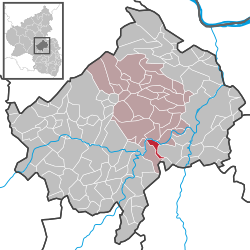Oberhausen an der Nahe
| Oberhausen an der Nahe | ||
|---|---|---|
|
||
| Coordinates: 49°47′35″N 7°45′30″E / 49.79306°N 7.75833°ECoordinates: 49°47′35″N 7°45′30″E / 49.79306°N 7.75833°E | ||
| Country | Germany | |
| State | Rhineland-Palatinate | |
| District | Bad Kreuznach | |
| Municipal assoc. | Rüdesheim | |
| Government | ||
| • Mayor | Horst Schmitt (acting) | |
| Area | ||
| • Total | 3.31 km2 (1.28 sq mi) | |
| Elevation | 128 m (420 ft) | |
| Population (2015-12-31) | ||
| • Total | 374 | |
| • Density | 110/km2 (290/sq mi) | |
| Time zone | CET/CEST (UTC+1/+2) | |
| Postal codes | 55585 | |
| Dialling codes | 06755 | |
| Vehicle registration | KH | |
| Website | www.oberhausen-nahe.de | |
Oberhausen an der Nahe is an Ortsgemeinde – a municipality belonging to a Verbandsgemeinde, a kind of collective municipality – in the Bad Kreuznach district in Rhineland-Palatinate, Germany. It belongs to the Verbandsgemeinde of Rüdesheim, whose seat is in the like-named town. Oberhausen is a winegrowing village. Oberhausen an der Nahe is one of two municipalities in the district with the name Oberhausen. The other is Oberhausen bei Kirn.
Oberhausen lies on the River Nahe at the foot of the Lemberg, the Middle Nahe's highest hill.
Clockwise from the north, Oberhausen an der Nahe’s neighbours are the municipalities of Schloßböckelheim, Niederhausen, Feilbingert, Hallgarten (although this boundary is very short), Duchroth and Waldböckelheim, all of which likewise lie within the Bad Kreuznach district.
In 1937, an ancient Roman estate was discovered at the Buchwald (forest). On the Lemberg was a Roman signalling station that relayed messages between camps at Kreuznach and Metz. Oberhausen itself (formerly called Husen) was founded in Merovingian times (5th to 8th centuries) and was within Disibodenberg Abbey’s sphere of influence. At the time of the partition of the Nahegau, the village passed in 1200 to the Counts Palatine of Zweibrücken, who enfeoffed the Knights of Montfort with it in 1274. Until 1700, Oberhausen was jointly held by the Houses of Boos zu Waldeck, Blick von Lichtenberg, Albrecht von Günterode and the Dukes of Zweibrücken-Veldenz. From 1789 to 1814, the village, along with all the German lands on the Rhine’s left bank, were ruled by Revolutionary and later Napoleonic France. After the Congress of Vienna, Oberhausen belonged as of 1814 to the Kingdom of Bavaria, and it remained in Bavaria through that state’s transition into a constituent kingdom of the German Empire (1879) and the Free State after the Revolution, in the Weimar Republic (1919) and the Third Reich (1933) until the end of the Second World War (1945), after which it became part of the then newly founded state of Rhineland-Palatinate in 1949, upon the creation of what is now known as the Bonn Republic. In the course of administrative restructuring in Rhineland-Palatinate, Oberhausen was transferred out of the now dissolved Rockenhausen district and into the Bad Kreuznach district. From an ecclesiastical standpoint, Oberhausen still belongs to the Evangelical Church of the Palatinate (Evangelical) and the Roman Catholic Diocese of Speyer.
...
Wikipedia



